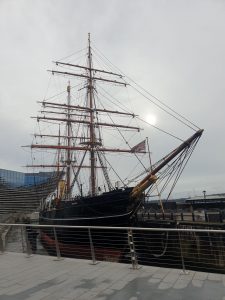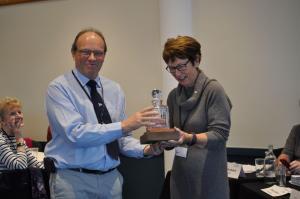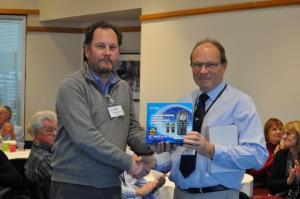The MOA Dundee Weekend Break
AGM and Prizegiving 28 February to 2nd March

2020 Award winners

9am on Saturday morning – feeling slightly jaded from the rendezvous in the bar on Friday evening – time to sign in and hand out tickets for the Saturday visits. Howard Williams (Scottish Branch Secretary) did a fantastic job keeping the Compass Editor and AGM coordinator on track
AGM report
Chris Allcock, Secretary, called the packed 34th Annual General Meeting to order at 11am and invited Richard Martin, Commodore to address those present.
Richard introduced the team at the top table and welcomed the 115 members of the MOA, many of whom had travelled long distances to Dundee for the event. He spoke of the good health of the Association with a stable Membership and a sound financial footing; the Association’s “three jewels” of the Website, magazine and the thriving Branches & Chapters. He briefly covered the projects and initiatives of the past year; both the outsourcing of Bookkeeping and the ongoing review of the membership system; changes which will have the benefit of making the administration of the MOA more robust, secure and less vulnerable to the loss of key personnel or IT hardware. Richard covered the Technical Library on the Website and the work involved scanning and cataloguing technical drawings from Marine Projects, boat manuals and technical instructions, along with historic photographs especially thanking those folks who give up so much time to make these things happen. “Without volunteers right across the Association, to be blunt, then things might not happen”. The full text of Commodore Richard’s address can be found at this link. “As you know my two-year term as Commodore comes to an end in about fifteen minutes. I have enjoyed immensely representing the MOA, in this capacity. I hope that I am passing the MOA to my successor in reasonable shape. My thanks and appreciation to all of you that have helped me and kept me out of trouble.”
Membership Registrar Roger Coppock (click here for his report in full) spoke of a thriving Association membership which remains at over 2000 with a healthy number of temporary and pending members in contact with the Association. Roger expressed thanks to Sally Ousbey for taking on the new role of Membership Assistant.
Paul Woodward, Treasurer, outlined the financial state of the Association where the accounts have shown a good operating surplus over the past year which will enable development of the new membership system without the need for any further increase in fees. (click here for his report) The continued appointment of the Independent Examiner was confirmed.
Finally, the “new” GC was installed, Chris Allcock remains as Secretary, Paul Woodward as Treasurer, Kevin Morgan was welcomed (back) to the post of Membership Registrar, Roger Coppock was handed the Vice Commodore’s pennant and Richard – took pleasure (tinged with just a modicum of sadness) in handing over the Commodore’s pennant to Colin Barber.

Roger Coppock receives the Vice Commodore’s flag

Richard Martin hands over the Commodore’s flag to Colin Barber

Paul Kennedy, previous Commodore, receiving honary membership of MOA in recognition of his work for the association
Weekend visits & Dinner


Saturday evening dinner
115 sat down to dine on Saturday evening in the City Quay Suite of the Apex Hotel. Before dinner, Commodore Richard Martin took time to introduce the diners to the General Committee of the MOA and appreciation was shown by all to Alison Martin for the support she had given to Richard during his two years in office. Fantastic food, good wines and great service from the staff together with a most solicitous Banqueting Manager made for a relaxed and enjoyable experience. Dinner was accompanied by a great background of photographs of Scottish sailing scenes assembled by Howard Williams, Secretary of the MOA Scotland Branch.Following dinner, we were treated to a wonderful illustrated insight into the maritime history of Dundee given by speaker Iain Flett.
To provide a fitting end to the evening, a few tunes from the Scottish Welsh Male Voice Choir … only in the MOA!!




The Unicorn as it should have looked
HMS Unicorn
On the recent trip to Dundee for the Moody Association AGM a group of us visited HMS Unicorn. We approached what looked like a long shed on a barge but is a 19th century sailing frigate built in Chatham in 1824 shortly after the Napoleonic Wars ended. Since the country was at peace she was not immediately needed for active service so rather than being rigged she had a roof built over her main deck and was laid up ‘in ordinary’ as part of the reserve fleet. This protection preserved her structure which we were told is 95% original. She is the 3rd oldest ship afloat in the world and equal in importance to HMS Victory and the Mary Rose. She was towed to Dundee in 1873 to be used as a drill ship for the city’s naval reserves and remained in service until 1964. During both World Wars she acted as the headquarters for Senior Naval Officers in Dundee. HMS Unicorn was saved from the scrap heap by the formation of the Unicorn Preservation Society. The ship was donated to the society by the Ministry of Defence and is now run as a museum ship by volunteers.


All captains at the table!

Desperate Dan (with the Treasurer). The comics were produced in Dundee
Verdant Works
The Jute Mills had occupied a large part of Dundee but now many had been demolished or converted, the Verdant Mill is the only surviving one. We were told of the working life and the terrible conditions; the air being so thick with fibres that colleagues could not see each other. Women were expected to work two looms at a time. They needed to be slim as the looms were positioned close together to fit as many as possible on the floor. The whale oil from the whaling industry important to Dundee in the 1800s was used to soften the jute so that it could be spun. In later years, mineral oil was used. Jute was mainly imported from India; following Indian independence, export of the raw material ceased and the jute was processed in India where there are still many jute mills in Calcutta, with the same appalling conditions for the workforce.
We were taken through a working section of the mill and given demonstrations of the various machines used for preparing the jute, the spinning process and then weaving. As we passed from room to room we came to a part which had working machinery which was operated by a gentleman called Billy who demonstrated and explained how each machine was used in order for the Jute to reach the final stages so it could be used for rope making, sailcloth, coarse weave for sacks of vegetables, close weave for sacks for flour and even clothes; production of backing for Axminster and Wilton carpets was very important and jute was a main component in the manufacture of linoleum


Mary Williams’ watercolour of the view from the window looking out at Discovery and the V&A


Previous commodores on the bridge – Lawrence and Annie Gander
RSS Discovery and the Discovery Centre
RRS Discovery in was built in 1901, the first vessel to be constructed specifically for scientific research. While the design was based on the great Dundee whalers (it was a wooden ship as it was judged that a wooden ship would stand up to being trapped in ice better than a steel one) Robert. Scott applied for the post of expedition leader. He was appointed in June 1900 at the age of just 33.
Forty-eight men started the journey south, each one hand-picked by Scott. Scientists apart, the complement were a mixture of merchant and naval seamen. After five months at sea, Antarctica was eventually sighted on January 8th 1902. Following many harrowing adventures, the aims of the expedition were met Discovery returned home in September 10th 1904 to a rapturous reception. Scott was acclaimed as a national hero.
RRS Discovery’s adventures continued, first with the Hudson Bay Company, then running munitions to Russia during the First World War. She was to make two further voyages to Antarctica before being laid up in London. In 1986 she made her return to Dundee and her final berth, a fitting memorial to the heroes of Antarctica.
By 1979 RSS Discovery was in a serious state of dilapidation. The first stage of her restoration was funded by a grant of £1/2 million from The Maritime Trust. Today, over 100 years after leaving Dundee, RSS Discovery sits proudly as the centrepiece of the Discovery Point Visitor Centre. The Visitor Centre is both a conference centre, where the AGM was held, and a museum holding many artifacts from the Antarctic voyages

Commodore Richard Martin at the helm

Jane Barber takes over the helm!

Walk to the ‘Dundee Law’
On Sunday, Bill Faerestrand led a party of intrepid MOA explorers to the top of Dundee Law. Its about 600ft above sea level, where we started. A good walk! The last bit was certainly quite steep and we all needed a rest. Coming down wasn’t much better, but we made it without getting soaked as the promised rain did not materialise although it was VERY windy at the top.

MOA members who made it to the top
Page compiled by David Longhurst – with thanks to contributors Ruth Cundy, Lawrence and Annie Gander, Julia Longhurst, Val and Geoff Lucas, Leo and Marilyn Compton










